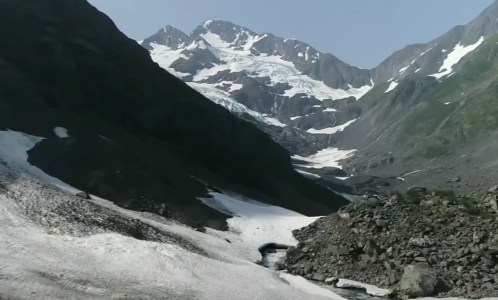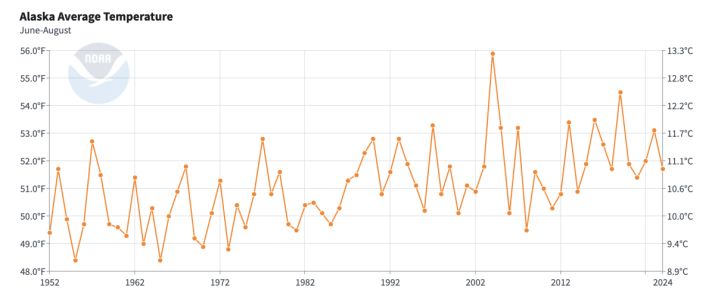Alaska faces extreme heat—what these new climate warnings mean for you
By
Veronica E.
- Replies 0
When most people think of Alaska, they picture snow-covered mountains, crisp cold air, and maybe a moose or two in the distance.
It’s known as America’s icy frontier—a place where even summer feels mild, and daylight can last all night.
But this year, that image is shifting in a surprising and serious way.
Instead of chilly breezes, the state is facing something far more unexpected: dangerously high temperatures.
For the first time ever, the National Weather Service (NWS) will begin issuing official heat advisories for both Fairbanks and Juneau.
It may sound unusual, but it’s a clear sign that climate change is making itself known in places many thought were untouchable.

Why is Alaska getting heat advisories now?
Alaska is warming two to three times faster than the rest of the world.
And it’s not just a number—residents are already seeing the effects in their daily lives:
Until now, the NWS used "special weather statements" to warn Alaskans about heat risks.
But beginning June 1, 2024, the agency will use clear, easily visible heat advisories—just like those issued in the lower 48 states.
Also read: Flames ahead? Why experts are worried about this year’s wildfire season
What counts as "dangerous heat" in Alaska?
If you're from a warmer state like Texas or Florida, 75 to 85 degrees might not seem alarming.
But in Alaska, homes are built to keep in warmth—not let it out—and air conditioning is rare.
During the summer, the sun barely sets.
So when it gets hot, it stays hot, both indoors and outside.
Here’s how the new advisories will be issued:
It may not sound extreme, but for older adults, children, and those with health conditions, this type of heat—especially in homes built to retain warmth—can quickly become dangerous.
Also read: Volcano alert: Is this Alaska volcano about to erupt?
The hidden dangers: wildfire, smoke, and sleepless nights
The heat isn’t the only concern. It sets off a chain reaction of other serious issues:
Also read: Think your home is safe after the wildfire? For many, the real nightmare is just beginning
Climate change on the frontlines
The transformations happening in Alaska are dramatic and undeniable:
Also read: New headlines show the Trump administration is steering climate policy in a new direction
What does this mean for the rest of US?
It’s easy to think, “I don’t live in Alaska—why does this matter to me?”
But Alaska offers a glimpse of what could be ahead for other parts of the country.
As the far north warms, the lower 48 may see similar patterns: hotter summers, more wildfires, and increasing health risks.
And for those over 60, this matters even more.
Older adults are more sensitive to heat, and many of us remember when climate change was just a distant concern.
Now, it’s something we all need to prepare for, no matter where we live.

Also read: Are you prepared for tornado season? Discover why DOGE’s latest move might affect you!
How to stay safe during extreme heat—even in unexpected places
Whether you’re in Alaska, Arizona, or somewhere in between, here are some key ways to stay protected during high heat:
At The GrayVine, we believe knowledge is power—especially when it helps protect our communities.
Let’s stay informed, look out for one another, and navigate this changing world together.
Read next: Catastrophic tornadoes strike—are you prepared for the next one?

Have you noticed unusual heat or changing weather in your area? Do you have tips for staying cool during summer? We’d love to hear from you. Share your stories and advice in the comments below!
It’s known as America’s icy frontier—a place where even summer feels mild, and daylight can last all night.
But this year, that image is shifting in a surprising and serious way.
Instead of chilly breezes, the state is facing something far more unexpected: dangerously high temperatures.
For the first time ever, the National Weather Service (NWS) will begin issuing official heat advisories for both Fairbanks and Juneau.
It may sound unusual, but it’s a clear sign that climate change is making itself known in places many thought were untouchable.

Alaska's changing climate is bringing unexpected warmth to regions once known for their icy landscapes. Image Source: YouTube / CBS Evening News.
Why is Alaska getting heat advisories now?
Alaska is warming two to three times faster than the rest of the world.
And it’s not just a number—residents are already seeing the effects in their daily lives:
- Glaciers and sea ice are shrinking at record rates.
- Wildfire smokes are growing more frequent and intense.
- Summers are longer and hotter, changing daily routines and the local environment.
Until now, the NWS used "special weather statements" to warn Alaskans about heat risks.
But beginning June 1, 2024, the agency will use clear, easily visible heat advisories—just like those issued in the lower 48 states.
Also read: Flames ahead? Why experts are worried about this year’s wildfire season
What counts as "dangerous heat" in Alaska?
If you're from a warmer state like Texas or Florida, 75 to 85 degrees might not seem alarming.
But in Alaska, homes are built to keep in warmth—not let it out—and air conditioning is rare.
During the summer, the sun barely sets.
So when it gets hot, it stays hot, both indoors and outside.
Here’s how the new advisories will be issued:
- Fairbanks region: Heat advisory at 75°F (North Slope) or 85°F (Interior)
- Juneau region: Heat advisory at 80°F or higher
It may not sound extreme, but for older adults, children, and those with health conditions, this type of heat—especially in homes built to retain warmth—can quickly become dangerous.
Also read: Volcano alert: Is this Alaska volcano about to erupt?
The hidden dangers: wildfire, smoke, and sleepless nights
The heat isn’t the only concern. It sets off a chain reaction of other serious issues:
- Earlier wildfire season: It now starts April 1, a full month earlier than it used to. Massive fire years are becoming twice as common.
- Lingering smoke: Wildfires mean smoky skies. Residents are often stuck choosing between opening windows for heat relief or keeping them shut to avoid smoke.
- Hot nights, poor sleep: In Fairbanks, nighttime temperatures have risen over 4 degrees since 1960. Without cool nights or air conditioning, homes can stay uncomfortably warm, affecting sleep and overall health.
Also read: Think your home is safe after the wildfire? For many, the real nightmare is just beginning
Climate change on the frontlines
The transformations happening in Alaska are dramatic and undeniable:
- Arctic sea ice is at record lows, melting earlier and coming back later.
- Wildlife patterns are shifting, with polar bears searching farther for food.
- Indigenous communities are adapting quickly, finding new ways to hunt, fish, and live amid the changes.
Also read: New headlines show the Trump administration is steering climate policy in a new direction
What does this mean for the rest of US?
It’s easy to think, “I don’t live in Alaska—why does this matter to me?”
But Alaska offers a glimpse of what could be ahead for other parts of the country.
As the far north warms, the lower 48 may see similar patterns: hotter summers, more wildfires, and increasing health risks.
And for those over 60, this matters even more.
Older adults are more sensitive to heat, and many of us remember when climate change was just a distant concern.
Now, it’s something we all need to prepare for, no matter where we live.

Data from the National Weather Service reveals a steady rise in Alaska’s average temperatures during the summer months of June through August. Image Source: National Centers for Environmental Information.
Also read: Are you prepared for tornado season? Discover why DOGE’s latest move might affect you!
How to stay safe during extreme heat—even in unexpected places
Whether you’re in Alaska, Arizona, or somewhere in between, here are some key ways to stay protected during high heat:
- Know the signs of heat illness: Watch for dizziness, headache, rapid heartbeat, or confusion. Move to a cooler place and get medical help if needed.
- Stay hydrated: Drink water regularly, even if you don’t feel thirsty.
- Keep your home cool: Use fans, close curtains during the day, and open windows at night if it’s safe.
- Check on neighbors: Especially older adults or those living alone. A quick call or visit can make all the difference.
- Be ready for wildfire smoke: Have N95 masks on hand and know where to find clean air shelters if needed.
At The GrayVine, we believe knowledge is power—especially when it helps protect our communities.
Let’s stay informed, look out for one another, and navigate this changing world together.
Read next: Catastrophic tornadoes strike—are you prepared for the next one?
Key Takeaways
- The National Weather Service in Alaska will begin issuing heat advisories for Fairbanks and Juneau for the first time this summer, in response to rising temperatures linked to climate change.
- Temperatures in Alaska are increasing two to three times faster than the global average, leading to warmer waters, shrinking glaciers and sea ice, more hazardous heat conditions, and increased wildfire risk.
- Buildings in Alaska are designed to retain heat, making high temperatures especially uncomfortable and dangerous—particularly during long summer days and periods of wildfire smoke.
- Climate change impacts in Alaska are real and visible, affecting ecosystems (such as Arctic sea ice and polar bears), advancing wildfire seasons, and presenting major challenges for locals—especially Indigenous communities—who are adapting rapidly to these changes.
Have you noticed unusual heat or changing weather in your area? Do you have tips for staying cool during summer? We’d love to hear from you. Share your stories and advice in the comments below!






